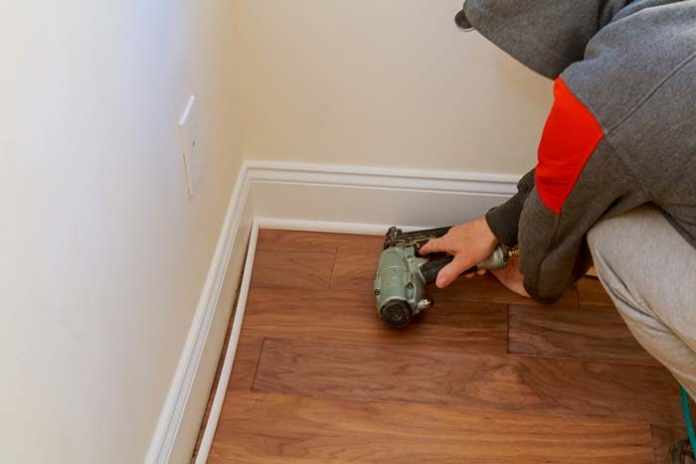What size Finishing Nails for Baseboards? Small nails with small heads are the finished nails. They are commonly used for shaping or finishing, for “finishing touches” Typically, they are immersed in the surface and leave a small hole that can be filled with putty and painted to give the nails and nails a smooth surface and invisible holes.
The finishing nails are made of steel and are available in various sizes and thicknesses. A calculation of the force of the nail is the measured size or thickness of the nail. 16-10 is the measuring scale, the smaller the measured size, the stronger the nail. The finished nails have a length of 2.5 to 10 cm. Also measured in “penny” units is the scale of the finished nails. To decide the length, the letter “d” is used. The 2D nail finish is 2.5 cm long in this form, and the 6d nail is 5 cm long.
What size Finishing Nails for Baseboards?
For all your DIY jobs, make sure you use the right nail size to ensure better longevity and a stronger grip no matter what you are trying to nail. Husky 30 gallon air compressor It’s difficult to select the correct nail, and each operation involves a different size or type of nail, which complicates matters further. Today, we will look at only one particular task here, and that is the method of attaching the motherboard.
Select the gauze size
Choosing the correct nail size for the base table is crucial because the wrong size will cause the table to break or worse. After all, the nails can pass through a cable or pipe dug into the wall and cause other problems. That is why we are here to help you out. Here’s a guide for your outlet to select the correct nail size, which will help you in choosing the perfect nail for your job safely and make your life easier.
The underlying concept is that the greater the number of meters, the fewer nails he uses. Nailers that pull larger nails of 15 and 16 gauge are finished nailers. A nail of greater thickness is recommended for base plates, which means smaller nails. It has a smooth surface that does not leave a small hole. Not much filling is needed.
Baseboard Material
It’s really simple. Since they fulfill the decorative needs of the home, the bases are available in various building materials. The aesthetics of the design, therefore, affect the decision of the base table material.
When choosing ready-made nails for the table, this in turn becomes essential. Nailers drive nails with great force, and nails can inflict tremendous damage and are hard and sharp. That is why, when selecting the ideal finishing nail, the right size and the right material go hand in hand.
Also, it is important to recognize your location’s climatic conditions. Depending on temperature and humidity, a wide variety of forests tend to shrink or extend. The form and size of the finish nails, which are therefore necessary for use in that unique cocoon, were unintentionally influenced by this.
We recommend that you keep the pads inside the house 24-48 hours before you nail them, to prevent this. Then they got used to the conditions of the internal temperature.
Using a punch
Where the base is not painted, this particular aspect is an important part of the finishing process. It would be advisable to lower the hole first in this situation, as stated earlier, and then use a putty. Although there are other ways to do this, to prevent injury, we recommend using a punch.
Drills in both hardware stores and mechanical workshops are readily available on the market. The drills not only make sure that the nails move through the boards easily, but the sharp tips on the top of the drills often make the operation easier.
8d Finish Nail
Have you ever wondered when you buy nails what “D” means? Nails are sold with a number followed by a “D” followed by duration for historical purposes. “D” means penny because the 8th nail is an 8-cent nail. This is how the nail’s length is calculated. The coin used by the Romans was renamed Denarius when the Romans occupied what we know as England today, which is also the name of the English penny.
There was a time when nails were forged by hand, one by one, and some say a 3-1/2 inch nail table would cost 16 cents a day, and they’ve been referred to as 16 nails. Others say “D” implies that it would cost 16 cents for one hand-forged 6D nail.
The strength of the nails is based on their diameter and length. It is forced enough into the supporting material if the nail is the correct length. The strength of a nail properly positioned often depends on its diameter, as the number of wood fibers to be added to the surface would be influenced by this. The wider the nail, the more it will wear wood fibers, thereby reinforcing the bond.
Best nails and nail guns for trimming baseboards
Brad Nailers are often the best nails for cutting the base since these high-groove nails are easy to keep discreet and minimize the chance of scratching the substrate. This means searching for runway numbers above 15 for the strongest and least visible surface, usually between 18 and 23 gauge. Any 18-23 nail size that is around 1 inch long should be suitable for the job!
If you don’t have a nail polish remover already, it’s probably worth purchasing a size 16 multi-tool for interior walls. For flexible surfaces and general interior use, this is the ideal gauge, providing a strong balance between finesse and power for greater flexibility.
Nailing Baseboards to the Wall
Let them sit indoors for up to 48 hours before nailing them to the wall once you have the plinth. The explanation is simple: when exposed to various environmental factors, wood can change shape. For thin wood, like paint, this is particularly true. They will change shape and then adapt when you first put them down.
You can end up with sloping plinths attached to the walls if you do not allow the floorboards to adapt, which causes a lot of problems. Then, let them stay in the rooms and hallways where they will be used for a few days.
After that, you can now fasten the baseboard to the walls. You can pre-drill holes if you like. Or you can start hitting it, if you use small nails, such as gauge 15-16, which are typically the most common for floorboards. Remember that even smaller nails may be used to connect the base, such as nails 16, 18, or even 23 gauge. Although the bigger 15-16 gauge can be used as a corner anchor.
You can sand the nail heads and fill the holes with putty or glue after installing the baseboard. You can paint the baseboards to match the wall when you’re finished or leave them as though they were not stained. You will want to safeguard the baseboard in any situation, so it is advisable to use stains or paint.
The benefit of plinths is that they not only provide extra protection to the wall but if they are broken, they can also be removed and replaced. Therefore, using suitable nails and techniques to lay the baseboard slabs will be useful.
Conclusion
We believe that our guide on the size of finishing nails for the baseboard gave you a full understanding of how to select the correct nail size for your base. During the cutting process, we recommend that you take extra precautions into account.
To give you the benefit of using and selecting the right equipment for many business operations, we are continuously updating our website. For more insightful guides like this, check our other articles.







